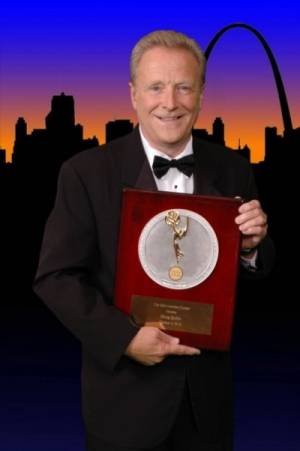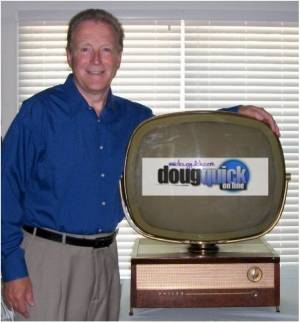Since 2012, I’ve had the privilege of working with Doug Quick at WICD Newschannel 15 (and more recently at Fox Champaign in the same building). I asked him about his award-winning career in Central Illinois and his role in researching the history of broadcasting in the area.
Smile Politely: Can you describe your initial interest in broadcasting and summarize your entry into the field?
 Doug Quick: When I was a tot, I spent a lot of time with my grandparents (my dad’s parents) as they were my parents’ child care providers in Taylorville. They kept a magazine “box” with select editions of TV Guides in it from 1953 to 1959 the then current year. I really didn’t like children’s books, so I spent many hours looking through the editions of TV Guide, and “studied” them, knowing the differences between the networks, the local stations and memorizing the schedules. My parents were young enough to listen to Top 40 radio in the early 1960s, so I was well acquainted with the music of the era as well. I guess both interests merged to bring me into the eventual career in broadcasting — radio from 1974 to 2002 and TV from 1994 to the present. When I was a kid, instead of having a favorite baseball team, I had a favorite TV network and followed the national TV ratings for years. (My favorite network, by the way, was ABC.)
Doug Quick: When I was a tot, I spent a lot of time with my grandparents (my dad’s parents) as they were my parents’ child care providers in Taylorville. They kept a magazine “box” with select editions of TV Guides in it from 1953 to 1959 the then current year. I really didn’t like children’s books, so I spent many hours looking through the editions of TV Guide, and “studied” them, knowing the differences between the networks, the local stations and memorizing the schedules. My parents were young enough to listen to Top 40 radio in the early 1960s, so I was well acquainted with the music of the era as well. I guess both interests merged to bring me into the eventual career in broadcasting — radio from 1974 to 2002 and TV from 1994 to the present. When I was a kid, instead of having a favorite baseball team, I had a favorite TV network and followed the national TV ratings for years. (My favorite network, by the way, was ABC.)
SP: Describe the experience of being “on air” for the first time.
Quick: My first radio “on air” experience was an accident of sorts. I was being trained on the control board at my hometown radio station, WTIM in Taylorville. The chief engineer was training me on the first night when he took a phone call that the morning announcer had been assaulted downtown by a jealous husband and had to go assist him. So that left me to jock records and read local commercials with very little training, but I think I did OK.
My first TV experience would go back to my time in college when I co-anchored the campus TV station, which showed up on the local cable system in Macomb at WIU. I don’t recall anything really being notable other than probably having a rather thick “radio” voice at the time. We were totally in black and white, no teleprompter, no electronic character generation, etc. I would later do many TV commercials for the Central Illinois TV stations during the 1980s and early 1990s.
SP: How/when did you make the transition from radio to television, specifically to being a TV meteorologist?
Quick: I was hired at WICD as promotions director in 1994, which gave me the opportunity to voice many news promos, program promos, and station promotional announcements. I later would do the weather on Sunday nights, one of the most watched and important local news nights of the week. I would also, when the occasion called for it, jump in to do local weather in the morning during the Today Show local news/weather cut-ins. When the station began to originate its own local morning newscast, I asked to take the position and got it. I left promotions and became a full-time weathercaster on weekday mornings and during the mid day newscasts. I went to the evening shift in October of 2002. That was also when I “retired” from radio as, up to that time, I was also jocking the 3 to 7 p.m. shift on WDNL, D-102 in Danville and hosting the “Sunday at the 70s” show on Sunday afternoons. All my radio work was pre-recorded via automation. I was pre-recorded on Sunday mornings and again late Wednesday nights.
SP: How have things changed since you first started forecasting weather?
Quick: Things have changed considerably and still continue to evolve. The technology is the big thing. The first weather computer I worked with was just one step away from having magnetic symbols on the weather map. It took 45 minutes to render a 10-second piece of video, which consisted of moving fronts/highs/lows and precip areas. We only had about 4 or 5 graphics done through the weather computer. All temps had to be manually loaded. The difference is similar [to going] from a “horseless carriage” to a Lamborghini! And I know there’s more improvements in the future!
SP: How difficult is it to adapt when something is altered in a show’s format, when a station changes the network they’re affiliated with, when a station comes under new ownership?
Quick: It’s very difficult across many platforms. First, it confuses the viewers, and it’s been my experience that viewers are confused already. I can’t tell you how many times that I’ve had someone say to me, “I watch you all the time on WCIA.” Or tell me they watch me every morning, when I haven’t done the morning show since 2002! Now, with the group control of several TV stations that cross-promote, it’s got to drive the viewers crazy. I remember all of the confusion when WICD went from NBC to ABC. There were some people who were really up in arms over the switch! Where were they going to watch Days of Our Lives?
When that occurred, all of the satellite dishes behind the building were removed and replaced by the ABC dishes. Racks and racks of equipment were replaced. A couple dishes were used for other programming and caused several days or several weeks of upheaval in the operation of the station. The set had to be changed. We had major branding that was done to the set, and it all had to be removed and/or replaced. From a sales department standpoint, it would be similar to one day being a Ford dealer and the next being with Chevrolet! Both are cars, but the features and benefits can be drastically different. Details of the change would range from all promos, regular station graphics and such had to be changed to reflect the new network and logo. Let’s not forget stationary, printed station material, mailing labels and business cards!
SP: How many different people do you think you have worked with through your career in television alone?
 Quick: Literally hundreds, and I’m terrible with names. Occasionally someone would return, and, even though I may have worked with them for a couple of years, I can’t remember their names for the life of me! If I was to arrange a reunion with all of them, I don’t know where I would hold it. McCormick Place is too small!
Quick: Literally hundreds, and I’m terrible with names. Occasionally someone would return, and, even though I may have worked with them for a couple of years, I can’t remember their names for the life of me! If I was to arrange a reunion with all of them, I don’t know where I would hold it. McCormick Place is too small!
SP: What is it like working in a field with a high employee turnover? How do you respond to seeing so many people come and go over the years?
Quick: It’s just part of the business, and I really haven’t thought too much about it. I do keep occasional contact with a few. Facebook helps me do that! I’m old enough to have worked with some real broadcast pioneers and for companies I have researched who really made a difference in the history of broadcasting!
SP: What is the fate of WICD Newschannel 15?
Quick: For all purposes, WICD no longer exists as a full service TV station for Champaign-Urbana, Danville, and East Central Illinois. It has been reduced to a translator for WICS, Channel 20 in Springfield. All of the work done by hundreds of great people here in Champaign from 1959 to 2015 went down the drain.
SP: What are some of the biggest misconceptions people often have about working in broadcasting?
Quick: Maybe I’ve been in it too long, but one thing I’ve discovered is that many people think that everyone working in local TV knows everyone else, even at the competitive stations. There were times I would go months without seeing many co-workers at WICD who I worked with from the other side of the clock! People ask me about what someone is like on the competing stations. I just tell them, “They’re all really great people.”
SP: What is your advice for those with aspirations to work in the industry?
Quick: That’s a tough one. It’s changed so much. It’s tougher to get into than it used to be. When I got my first radio job, I stopped into my local radio station and sold the general manager on putting a rock and roll show (hosted by me) on his automated beautiful music station every night. That would never happen today. For one thing, there are virtually no beautiful music stations out there today!
SP: How did you first become interested in researching the broadcast history of Central Illinois?
Quick: I saw the value in “branding” my name and personality with a website. I purchased www.dougquick.com ahead of all of the other Doug Quicks out there (and there are quite a few), and then had to come up with something to put on the site other than my picture. No one’s going to visit a picture of me! I used those old TV Guides to begin a broadcast history theme, and my research began into all of the local Central Illinois TV stations. I also included some radio history and automated radio history, as that was one part of radio that fascinated me. I’ve collected many items and pictures, testimonials from other broadcasters and such, and included the information on my site. I originally taught myself HTML and started building from scratch, until coming up with software to do most of the work. I still use the original software from the old Netscape browser program which is light years old. It works well for me.
SP: What has the research entailed on your end?
Quick: I have visited all of the public libraries from Springfield, Decatur, Champaign, Danville, and Bloomington to go through years of microfilm, looking for coverage of the building of the local TV stations. I’ve also looked for TV listings on the years that I didn’t have TV Guides. I’ve talked to many, many people via e-mail who have found my site and responded.
One incredible experience was just a couple of years ago. Growing up with local TV, there was one guy who was extremely versatile in that he hosted the teen dance show for a while in the late 50s, then did many TV commercials as well at WTVP (now WAND) in Decatur. I really admired his work and wanted to be “like him.” I couldn’t remember his name, though. Now flash forward to a couple of years ago, when I was hosting a Holiday Open House at Kennekuk County Park near Danville as part of my work with the Vermilion County Conservation District Foundation. A woman started up a conversation with me; she said she had a brother who used to work in Decatur TV. I gave her one of my cards and told her to drop me an e-mail. A few days later I got an e-mail from her brother who was living in the southern US. We e-mailed a few times, and I asked him if he had some pictures. He did and sent them to me via e-mail. AND WOW! That was the guy! His name was Frank Monte. It was a major quirk of fate! I also passed along a photo of a Central Illinois TV personality who had no children and no local family, but her niece had found my site and wanted a photo of her aunt in a professional setting; she had never seen her aunt on TV. I smuggled an extra one from WICS and sent it to her in Florida. I have heard from many children and grandchildren of many Central Illinois broadcast pioneers.
All of the information I’ve collected, only a small fractionof which is on my website, will hopefully be published in book form soon. Each time I think I finish, a new source of information comes to light, and I start in again.
SP: How would you say the history differs from other regions’?
Quick: Central Illinois has a unique market. It used to be two separate markets but was combined in the mid 1960s. Every station in the market has a different set-up. It’s not like Peoria, Quad Cities, St. Louis, or Indianapolis, in which all stations are in the same metro. Here, each separate metro has its own station. It creates nearly a non-competitive environment within a highly competitive industry.
SP: What is most important about the history of Central Illinois broadcasting?
Quick: What’s important here is important in any market. There have been people passing through every TV station in Central Illinois who have gone on to be famous within the media. Probably one of the most famous people to work in Central Illinois TV worked in Danville at WDAN-TV. Oscar-winning actor, Gene Hackman was an artist and a member of the crew at Channel 24 in the late 1950s. There have been many individuals who have passed through Central Illinois who, through their dedication, have made broadcasting and journalism a better field to work in. I especially respect those who got into this business at the beginning during the early 1950s.








